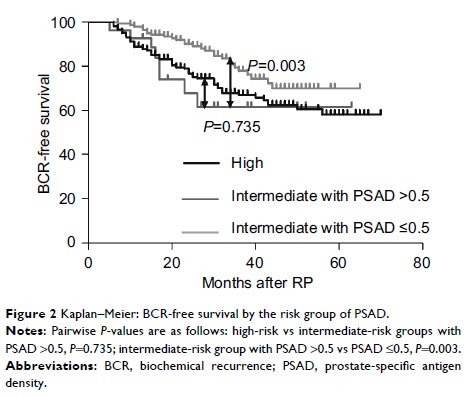108384
论文已发表
注册即可获取德孚的最新动态
IF 收录期刊
- 3.4 Breast Cancer (Dove Med Press)
- 3.2 Clin Epidemiol
- 2.6 Cancer Manag Res
- 2.9 Infect Drug Resist
- 3.7 Clin Interv Aging
- 5.1 Drug Des Dev Ther
- 3.1 Int J Chronic Obstr
- 6.6 Int J Nanomed
- 2.6 Int J Women's Health
- 2.9 Neuropsych Dis Treat
- 2.8 OncoTargets Ther
- 2.0 Patient Prefer Adher
- 2.2 Ther Clin Risk Manag
- 2.5 J Pain Res
- 3.0 Diabet Metab Synd Ob
- 3.2 Psychol Res Behav Ma
- 3.4 Nat Sci Sleep
- 1.8 Pharmgenomics Pers Med
- 2.0 Risk Manag Healthc Policy
- 4.1 J Inflamm Res
- 2.0 Int J Gen Med
- 3.4 J Hepatocell Carcinoma
- 3.0 J Asthma Allergy
- 2.2 Clin Cosmet Investig Dermatol
- 2.4 J Multidiscip Healthc

前列腺特异性抗原密度和活检初级 Gleason 评分的性能特征,以预测接受根治性前列腺切除术的中危前列腺癌患者的生化失败
Authors Peng C, Zhang J, Hou JQ
Received 10 October 2018
Accepted for publication 27 December 2018
Published 1 February 2019 Volume 2019:11 Pages 1133—1139
DOI https://doi.org/10.2147/CMAR.S190443
Checked for plagiarism Yes
Review by Single-blind
Peer reviewers approved by Dr Colin Mak
Peer reviewer comments 3
Editor who approved publication: Dr Antonella D'Anneo
Background: Prognosis
for intermediate-risk prostate cancer (PCa) remains variable; therefore, we
aimed to investigate high-risk factors for biochemical recurrence (BCR), and
intermediate-risk PCa using radical prostatectomy to identify patients having
equivalent BCR-free survival rates when compared to high-risk PCa.
Patients and methods: A total
of 441 medical records were analyzed, including those of 169 intermediate-risk
and 272 high-risk PCa patients. Risk factors for time to BCR were tested and
analyzed using Kaplan–Meier survival analysis, log-rank tests, and Cox
proportion hazards models.
Results: In the
intermediate-risk group, prostate-specific antigen density (PSAD) and primary
Gleason pattern were significant preoperative risk factors for BCR. Moreover,
BCR-free survival of patients in the intermediate-risk group with a higher PSAD
(>0.5 ng/mL/cm3) was comparable with that of patients in the
high-risk group (P =0.735). When combining primary Gleason pattern 4 and
3 with PSAD cut-offs 0.3–0.7 ng/mL/cm3, we found that
BCR-free survival of patients in the intermediate-risk group with a primary
Gleason pattern 4 and PSAD >0.3 ng/mL/cm3 was
comparable with that of patients in the high-risk group (P =0.463).
Conclusion: PSAD and
primary Gleason pattern are potential risk factors associated with biochemical
failure in intermediate-risk PCa patients after radical prostatectomy.
Regarding significant differences in prognosis according to PSAD as well as
primary Gleason pattern on biopsy, a subset of the intermediate-risk patients
could be identified with outcomes that were equivalent to that of high-risk
patients.
Keywords: biochemical
recurrence, Gleason grade, intermediate risk, prostate cancer, PSA density
